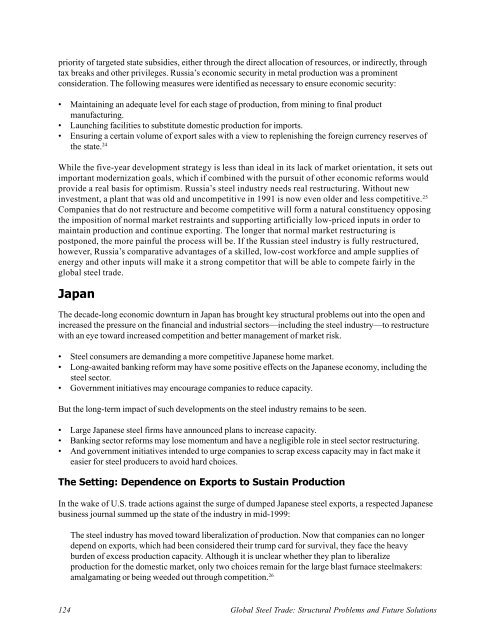Global Steel Trade; Structural Problems and Future Solutions
Global Steel Trade; Structural Problems and Future Solutions
Global Steel Trade; Structural Problems and Future Solutions
You also want an ePaper? Increase the reach of your titles
YUMPU automatically turns print PDFs into web optimized ePapers that Google loves.
priority of targeted state subsidies, either through the direct allocation of resources, or indirectly, through<br />
tax breaks <strong>and</strong> other privileges. Russia’s economic security in metal production was a prominent<br />
consideration. The following measures were identified as necessary to ensure economic security:<br />
• Maintaining an adequate level for each stage of production, from mining to final product<br />
manufacturing.<br />
• Launching facilities to substitute domestic production for imports.<br />
• Ensuring a certain volume of export sales with a view to replenishing the foreign currency reserves of<br />
the state. 24<br />
While the five-year development strategy is less than ideal in its lack of market orientation, it sets out<br />
important modernization goals, which if combined with the pursuit of other economic reforms would<br />
provide a real basis for optimism. Russia’s steel industry needs real restructuring. Without new<br />
investment, a plant that was old <strong>and</strong> uncompetitive in 1991 is now even older <strong>and</strong> less competitive. 25<br />
Companies that do not restructure <strong>and</strong> become competitive will form a natural constituency opposing<br />
the imposition of normal market restraints <strong>and</strong> supporting artificially low-priced inputs in order to<br />
maintain production <strong>and</strong> continue exporting. The longer that normal market restructuring is<br />
postponed, the more painful the process will be. If the Russian steel industry is fully restructured,<br />
however, Russia’s comparative advantages of a skilled, low-cost workforce <strong>and</strong> ample supplies of<br />
energy <strong>and</strong> other inputs will make it a strong competitor that will be able to compete fairly in the<br />
global steel trade.<br />
Japan<br />
The decade-long economic downturn in Japan has brought key structural problems out into the open <strong>and</strong><br />
increased the pressure on the financial <strong>and</strong> industrial sectors—including the steel industry—to restructure<br />
with an eye toward increased competition <strong>and</strong> better management of market risk.<br />
• <strong>Steel</strong> consumers are dem<strong>and</strong>ing a more competitive Japanese home market.<br />
• Long-awaited banking reform may have some positive effects on the Japanese economy, including the<br />
steel sector.<br />
• Government initiatives may encourage companies to reduce capacity.<br />
But the long-term impact of such developments on the steel industry remains to be seen.<br />
• Large Japanese steel firms have announced plans to increase capacity.<br />
• Banking sector reforms may lose momentum <strong>and</strong> have a negligible role in steel sector restructuring.<br />
• And government initiatives intended to urge companies to scrap excess capacity may in fact make it<br />
easier for steel producers to avoid hard choices.<br />
The Setting: Dependence on Exports to Sustain Production<br />
In the wake of U.S. trade actions against the surge of dumped Japanese steel exports, a respected Japanese<br />
business journal summed up the state of the industry in mid-1999:<br />
The steel industry has moved toward liberalization of production. Now that companies can no longer<br />
depend on exports, which had been considered their trump card for survival, they face the heavy<br />
burden of excess production capacity. Although it is unclear whether they plan to liberalize<br />
production for the domestic market, only two choices remain for the large blast furnace steelmakers:<br />
amalgamating or being weeded out through competition. 26<br />
124 <strong>Global</strong> <strong>Steel</strong> <strong>Trade</strong>: <strong>Structural</strong> <strong>Problems</strong> <strong>and</strong> <strong>Future</strong> <strong>Solutions</strong>
















